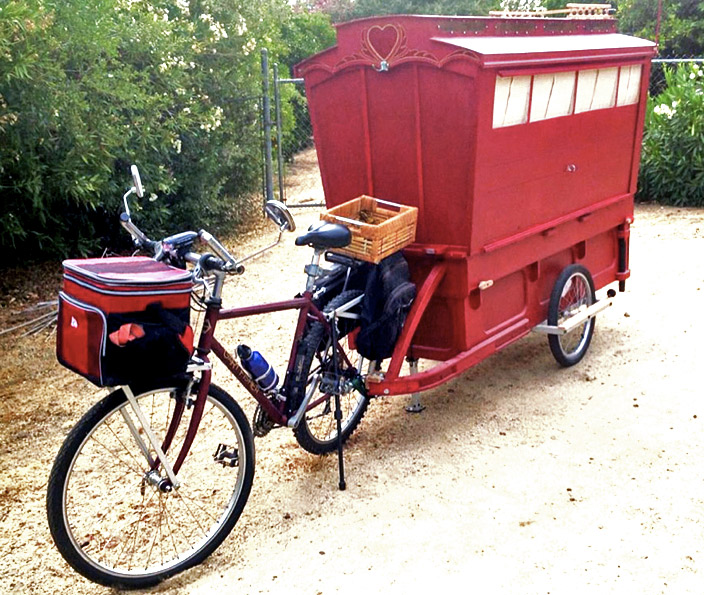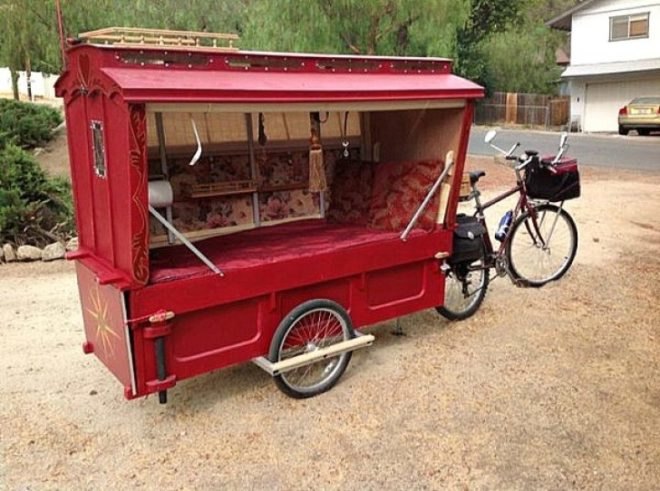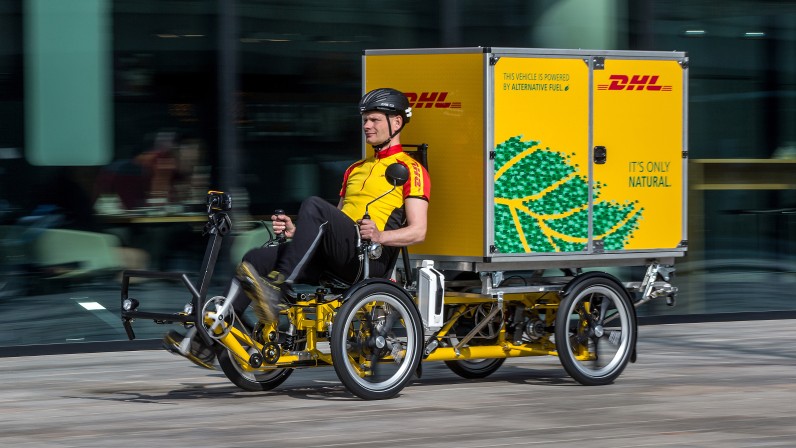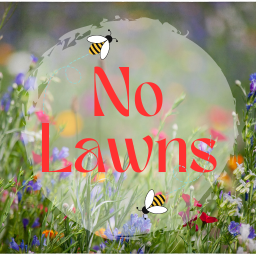

Happy to help!
I write science fiction, draw, paint, photobash, do woodworking, and dabble in 2d videogames design. Big fan of reducing waste, and of building community
https://jacobcoffinwrites.wordpress.com
@jacobcoffin@writing.exchange


Happy to help!


There was this very cool handmade bike trailer wagon thing: https://slrpnk.net/post/1833883


For the artist’s experiences living out of it: https://theaimlesslywanderingartist.blogspot.com/2013/12/winter-comes-to-southern-california.html
But that’s a trailer. It sounds like you’re describing something closer to a Bicycle Rickshaw, possibly on a tricycle frame.

You could even do a recumbent bike:

It seems like either could be enclosed using techniques learned from popup campers for a fairly comfortable living space.
(I think a lot about all the crazy contraptions people would make if the roads weren’t exclusively the domain of giant trucks and SUVs, and if cargo bikes didn’t have to fit themselves into narrow bike lanes and roadsides. I think people would come up with some really cool and weird stuff. Add solar panels and ebike parts, and they’d get really interesting.)


That’s true of sedans and hatchbacks too though. Any reasonably sized car is unsafe while sharing the road with the giant trucks and SUVs they’re making to skirt around emissions requirements. I know Kei trucks in particular further lack crumple zones and other protections, but they’re otherwise so practical I wish there was a way to get them approved. Not every vehicle should be built to double as a daily driver.
My long-term dream is a much less car-dependant society, where most people have access to public transit and vehicles like this are there for actual truck purposes.
Speed limits would be a nice change, if only because they could reduce the endless campaign to expand roads to make them safer at higher and higher speeds, but I think it’d be an endless, contentious fight with very little to prevent people (who’ve spent their whole lives dependant on cars for anything they need) from changing them back. I have been impressed with my city for gradually narrowing it’s streets and converting lanes into restaurant space, bike lanes, and I think parks.


I love this kind of solarpunk art, showing largely practical reuse of existing buildings and infrastructure. Especially with the modifications to strengthen community and reduce car reliance.


Absolute worst case, the pavement was used to cap a contaminated site (rather than excavate the contaminated soil and move it to a lined and capped landfill).


Yeah I don’t think they’re talking about you


It depends on what you need to enjoy the space.
If you’re looking for a grass alternative and aren’t running around on it all the time, roman chamomile can be a good, low-growing, pet-safe plant. We used this on my neighbor’s postage stamp front lawn so he wouldn’t have to mow but it would still look nice and intentional. There are also a handful of other low-growing plants which require much less maintenance and are more drought-tolerant than grass, but they tend to be best for low-traffic areas, so if you’re out there playing catch or capture the flag with your kids most days they’re probably not as good as grass.
If you’re in a shady area, moss might be an option. It also prefers low traffic.
And the option abhored by HOAs and your fussiest neighbors: just don’t bother maintaining a perfect lawn. A lot of the work and environmental damage comes from keeping a perfect monocrop of a specific grass cultivar. Fertilizer to keep the soil good enough (which gets washed into local waterways and causes algae blooms) pesticides (which kill bees and a slew of other insects) and herbicides to kill any plants that try to compete with the grass (which remain in the soil as well). Traps for rodents that try to exist in the yard. Not to mention the energy and person-hours spent on trimming it frequently. Just accepting that grass isn’t really meant to form a thick lawn in most areas, and will look a bit patchy, multi-hued, and feature some other plants, will greatly reduce the effort and damage caused.
Or if you can’t stand the thought of doing that (or will get in trouble) consider downsizing it a little - section off the least-used sections of your lawn, plant some cool native trees or shrubs, throw down some mulch so it looks intentional.
And the last option (where applicable): no grass.
When I was a kid our house was in the woods, with no clearing to speak of, so we mostly just played on the forest floor, which was mostly leaves and pine needles. If you pick up the sticks and keep it somewhat open, it can look really beautiful.
Some kindle books I ‘owned’ recently got updates pushed to them, which in this case included a new cover or I probably wouldn’t have noticed. In 1984 they were fucking about with recalling books and issuing ‘corrected’ ones. But with online media, centralized in a company’s server, it’s comparatively easy to push changes.


Thank you! And thanks for the reminder to update the links, I’ll fix those shortly.
I actually haven’t heard of We3 but I’ll check it out, thanks for the recommendation!


Ah, thanks! I knew I was missing something
Whoops, I saw it in my inbox and assumed it was a reply rather than because you tagged me - my bad!
Sorry, I think you replied to the wrong comment. Thanks for the shout-out though!


I’m sorry, I’ve not seen the film and though I read the wikipedia article I don’t get the reference. I used a quonset hut mostly because they’re a common, cheap metal building that used to be really common around here. As housing or workshop space they’re apparently really unpleasant, but you still see them a lot. Many of the comics and all the still panels are at least partially me trying to catch a specific kind of place/time of day/type of weather, from my hometowns, and filter it through the lens of cyberpunk, so this is mostly that.
In that case I’ll try to answer without giving too much away! The campaign uses the setting from the game Fully Automated! but is set in a region of the former United States which the rulebook largely overlooks. So general stuff like the history of the world still applies, and the players are free to read up on it, but I’m writing my own historical events when it comes this specific fictional, abandoned town and the area around it.
The players are on a quest to find a forgotten buried treasure (several tons of illegally-dumped industrial waste now useful in the production of geopolymers) in a mostly abandoned town currently undergoing deconstruction and rewilding. Their search will unearth many forgotten details of the region’s chaotic history from during the setting’s Global Climate War 60 years before.
This project has actually been a bit of an extension of my Postcards from a Solarpunk Future project! Building out all the places and options for the players to explore has allowed me to write in way more worldbuilding than I could get away with in a normal fiction project (though the players won’t see all of it). Similar to the postcards where each is just a picture and little worldbuilding essay, no plot. It’s also let me focus on aspects of solarpunk that I realized really interests me while working on the postcards. Stuff like reuse, rewilding, deconstruction, and generally what rural areas might look like in a solarpunk world, especially current-day bedroom communities.
As for the art, I’d been running out of ideas I was excited about for the postcard series, but since starting in on this, writing all these new locations, I’ve found a bunch of new scenes I’m really excited to do the art for.
I wouldn’t say it’s critical to the campaign exactly, but the scenes and maps will be something the GM can put up on screen on Roll20 to set the tone and feel, or to help the players picture their surroundings. Character portraits might help them remember who’s who.
As for a moral, I’ve definitely got things I want to explore: the motives for and consequences of a sort of negative peace, the shifting value of things like industrial waste based on use (and generally the very rare win-win where a waste product from one process becomes a useful input in another), the priorities of society and how it might look when one has very different goals than profits. Generally I want to explore what very rural places like my hometowns might look like when society has moved away from cars. And to generally tout values like thrift and reuse. But I’m not sure if I have a specific moral in mind.


This may be a dumb question but are these wheel hubs like car hubs where you can open them up to get at the brakes? If the hubs themselves are hard to replace maybe the brake pads themselves would be easier? Something you could replace with a generic pad cut to size or something?
I think I made some good progress on the campaign I’m writing for the Fully Automated TTRPG. I’ve built up some of the history around the mystery the players will be investigating, some of the characters and their interconnections, and places where the players will be able to access that information. I’ve also built out the locations a good bit more, most of which aren’t directly related to the plot, but at least it means there’ll be answers ready for any GM who has to field questions about how the community handles this or that aspect of life. I’ve started gathering up all the characters I’ve mentioned in various sections so far and organizing them in the characters section of the doc, and have started building out details for them.
At this point, my goals are to build out the mystery further, to add more slip-ups and connections to the cold case murder mystery, more ways for the players to find the long-forgotten toxic waste dumping. I’ve done a lot of work on the nearby modern village where they start off, but the abandoned town itself is still light on landmarks so I need to build those out. I also have a lot more characters to describe and eventually stat out.
Eventually I want to polish up the feel of it, to give it a bit of an adventure-movie feel, full of exploring lost ruins and wild forests, unraveling a mystery and searching for buried treasure. But the treasure is illegally-dumped industrial waste, the ruins and forests are in the Northeast United States. Building out the art assets included with the module book should help with that a bit.


Thanks! That reminds me: one thing I did on the second and third book blocks was clamp them further in, so they were more or less flush with the boards. (I think the bookbinding book said to let it stick out a bit). That let me compress the spine an extra millimeter or two, so it wasn’t as flaired as on the first one. I think it’s always going to be a little thicker on the spine side because of all the folds and thread, but I think this looks better.


Thank you so much! I’m very grateful for the sheer amount of high quality guides and resources available for free - the bookbinding community seems to be very generous with their knowledge. I basically just read and followed them carefully. I’m also lucky to have access to some great workspaces/tools.
Site prep is key, so make sure to bring a sledgehammer.